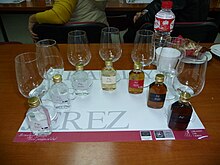Brandy de Jerez
Being unable to drink the already famous wines to be found in the Jerez region for religious reasons, the Moors opted to distil them in order to obtain “alcohol” not only to make perfumes but also for antiseptic and medicinal use.
The eighteenth and nineteenth centuries saw the consolidation in Spain of the production of wine spirit for commercial use destined for exportation, especially to countries in Northern Europe.
Brandy is an English adaptation of the original Dutch word “brandewijn” (burnt wine) whilst the term holanda (name given to wine spirits of low alcoholic content used in the production of Brandy de Jerez) is derived from the name of the country to which most of the exports were destined: Holland.
The term 'brandavin' was already in use in picaresque literature of the 17th Century, as can be seen in “The Life and Works of Estebanillo González, man of good humour”.
The method has three main characteristics: In Jerez it is also possible to use wine spirits of a higher degree of alcoholic content, but never (by decree of the Consejo) more than 50% of the total.



